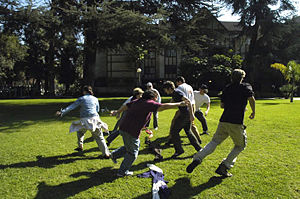Rock-Paper-Scissors Tag
| Rock-Paper-Scissors Tag | |
|---|---|

| |
| Designer: | Bernie DeKoven, funsmith |
| Year: | unknown |
| Players: | 6+ |
| Stuff required: | Three boundary lines (chalk, rope, or anything). |
| Crew required: | None. |
| Preparation: | None. |
| Time required: | Five minutes. |
| Place required: | Anywhere with space to run. |
| Activities: | Running, listening, shouting. |
| This is a playable game - it's finished, tested and ready to play. | |
| This game is made available under an Attribution-Noncommercial Creative Commons licence. (What does this mean?) | |
Of all the "New Games" I taught to the remarkably playful folk of the Interactive Media Division at the University of Southern California, Rock-Scissors-Paper Tag was the clear and most enduring favorite.
Rules
Two teams stand facing each other across a boundary line. There is another boundary line, behind each team, about, o, maybe 10 yards away. Maybe 20.
Before they assemble at the center line, both teams have decided what they want to be, as a team - rock, scissors, or paper. (To experience thorough preparedness, teams are encouraged to select a back-up symbol, to be used in case of a tie.) At the mutually agreed-upon moment, both teams, simultaneously, display their choices.
The team with the winning symbol (as in, you know, paper covers rock, rock smashes scissors, scissors cuts paper), attempts to tag everyone in the other team before anyone can cross the back boundary line. The excitement of impending victory, and the sheer suddenness of it all, as illustrated in the photo, frequently results in players not knowing which way to run. All to the general glee.
But perhaps the single-most joy-producing aspect of the game - the one which caused the game to be so deeply embraced by its players - can be traced to yet another rule (similar in effect to that of Red Rover - and illustrating with great panache the impact of the Second Way of the Seven Ways to Make Almost Anything More Fun) in which players who are tagged must join the winning team, thus, at least hypothetically, sooner or later everyone is on the winning side. The social implications of this rule are perhaps as vast as the fun it produces.